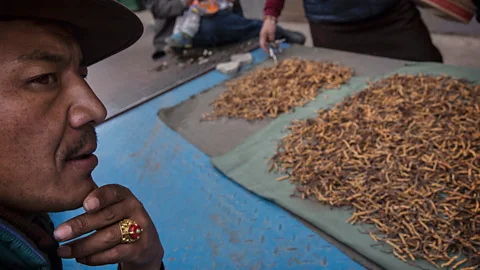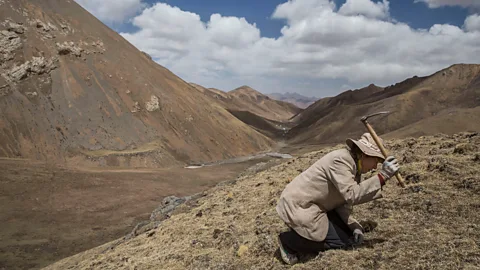The worms that cost $20,000 a kilo
 Getty Images
Getty ImagesHow much would you pay to eat a delicate fungus growing out of a dead caterpillar’s head? Considerably less than many Chinese aficionados, probably...
At a stall near the entrance of a grocery store in southern China, the shopper is greeted with delicate arrangements of dried objects. Lean in a little closer, and you'll see that they are inch-long dead caterpillars, with stalks growing out of their heads.
This may be the part of the country where people proudly claim that they'll eat anything with two legs that isn't a person and anything with four legs that isn't a table – the way Texans will brag about eating barbecue – but in this case, the caterpillars and their appendages are a nation-wide craze. They are gathered in Tibet and the Himalayas, and those stalks are fungi – Ophiocordyceps sinensis, to be exact – that take over their hosts, kill them, and then burst flamboyantly out of their heads.
These parasitic growths are interesting from a natural history perspective. But the reason they're arranged so carefully is that Chinese traditional medicine holds that they're good for just about anything from asthma to cancer.
 Getty Images
Getty ImagesThey're also, perhaps more importantly, the kind of thing that cures low social status in the possessor, a trait shared in common with caviar and mink coats. And so they are estimated to sell for in excess of $20,000 (£16,000) per kilo, sometimes much, much more. That's at least 10 times the cost of black truffles.
The fantastic story of the caterpillars and their fungus begins thousands of miles away, where people spend each spring crawling on their hands and knees up mountainsides, looking for a tell-tale stalk. A remarkable telling of the caterpillar fungus's rise can be read over at National Geographic, where Michael Finkel wrote about going to Tibet to see the harvest for himself a few years ago. One couple he followed manages to sell their 30 hard-won “worms” for 580 RMB, or $90, but in the cities a pound of high-quality specimens can sell for $50,000 (£40,000), he writes.
You don't need to eat that many, at least not all at once. People steep them in water by the ones and twos and put them in medicinal soups. It's still a considerable investment, with a quality worm or two coming out to something like $10-15 (£8 to £12). A pint of imported ice cream, a very pricey item in a Chinese grocery store, is about that much. The caterpillars are often sold alongside other trophy items, like sea cucumbers, whose popularity in China has led to sea cucumber gold rushes in other parts of the world that decimate their numbers.
The caterpillars and their hangers-on have felt the press as well. The same industry helps drive the slaughter of elephants and rhinos; when highly intelligent creatures are killed for the supposed effects of consuming their horns, it's enough to make any species quake in its boots.
 Getty Images
Getty ImagesAnd the caterpillar fungus gold rush hasn't been healthy for some humans, either. In 2010, two men turned up dead after a dispute in Nepal over them. (In that story, Eric Hansen tells of going to the village to follow the aftermath.) The fungus is now listed as an endangered species in China.
However, a 2016 CNN report suggests that demand for the worms may be declining as a result of the anti-corruption campaign currently underway in China; a pricey gift box of Ophiocordyceps sinensis may be more of a liability than a pleasure to an official.
And it also seems that the caterpillars are growing harder and harder to find. Kevin Frayer, a Getty photojournalist whose work is the focus of that article, travelled to watch the harvest and says that in some areas where people used to find hundreds a day, now they found perhaps four or five.
It remains to be seen what will happen to the sky-high price of caterpillar fungus, the fungus itself, and the communities that have come to depend on its returns. Boom-and-bust cycles are far from unknown, in luxury foods – in fact there was, for a time, an American caviar industry, which flourished for a handful of decades in the 1800s before going bust, as Michelle Nijhuis recounts in her gripping story Caviar's Last Stand. (At the time, the town of Caviar, New Jersey, produced more caviar than anywhere else in the world.)
Crashing sturgeon populations called a halt to that particular boom, and incredible rises and falls in the fortunes of caviar producers have been a fixture in the centuries since.
For the moment, while the caterpillars' fortunes may be in limbo, their dried bodies still fetch a princely sum: At the stall in the grocery store, two gift packages were on discount sale for 12,000 RMB, or approximately $1,800 (£1,460). A rich dish, whichever currency you use.
700,000+ Future fans by liking us on Facebook, or follow us on Twitter, Google+, LinkedIn and Instagram
If you liked this story, sign up for the weekly bbc.com features newsletter, called “If You Only Read 6 Things This Week”. A handpicked selection of stories from BBC Future, Earth, Culture, Capital, Travel and Autos, delivered to your inbox every Friday.
